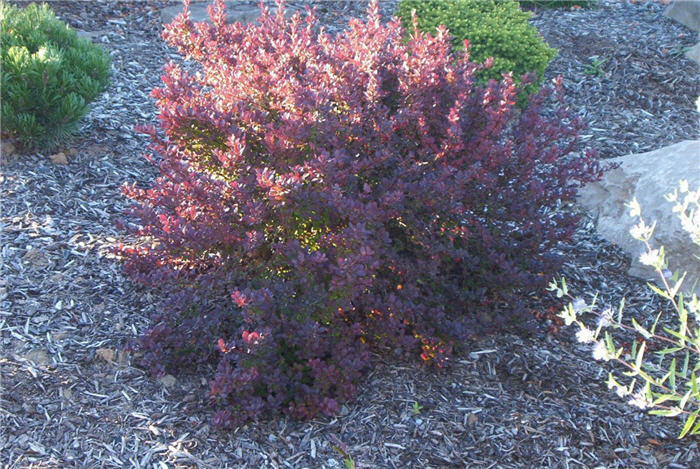| Botanical Name: Berberis thunbergii 'Gentry' | |
| Common Name: Royal Burgundy Barberry |

-
Anatomy
-
Culture
-
Design
Plant Type
Shrub
Height Range
1-3'
Flower Color
Yellow
Flower Season
Spring
Leaf Color
Red
Bark Color
Brown, Red
Fruit Color
Red
Fruit Season
Winter, Fall, Persistent
Sun
Full
Water
Low, Medium
Growth Rate
Slow
Soil Type
Sandy, Clay, Loam, Rocky, Unparticular
Soil Condition
Average, Rich, Poor, Well-drained, Dry
Soil pH
Neutral, Basic
Adverse Factors
Thorns/Spines
Design Styles
English Cottage, Formal, Japanese, Mediterranean, Ranch
Accenting Features
Fall Color, Unusual Foliage
Seasonal Interest
Winter, Spring, Summer, Fall
Location Uses
Perennial Border, Shrub Border, Foundation, Patio
Special Uses
Hedge, Fire Resistant, Small Spaces
Attracts Wildlife
Birds
Information by: Stephanie Duer
Photographer: Tina Olsen Binegar
Photographer: Tina Olsen Binegar
-
Description
-
Notes
This is a Japanese barberry cultivar that is a selection of 'Crimson Pygmy' chosed for its deeper red, nearly velvety color which holds well in the heat of the summer. Fall color is a deep, nearly black red. It has a dense, mounding form and grows about 2 feet tall and 3 feet wide. Yellow spring flowers are followed by shiny red, torpedo-shaped berries that ripen in fall and persist into winter; enjoyed by birds. Use this little barberry in the perennial border, or near the fron of the shrub or foundation border. It would also be a great color and textural contrast to larger ornamental grasses.
Grow in well drained soil and full sun; will tolerate part shade, though the leaves will lose some color intensity. Tolerates a wide range of soil types, including dry soils; does not tolerate wet soils. See guide for planting instructions. Barberry does not fair well when sheared, but selective pruning in late winter can maintain a nice form and convenient size. See guide for pruning tips.